The articulations of the human body resist the daily burden, so they become susceptible to various types of destructive factors. Among the diseases of the joints, is often osteoarthritis and affects large and small joints. The osteoarthritis of the knee joint is a degenerative-divophical damage in the knee joint, in which its motor activity is altered. In the absence of proper treatment, the disease can cause disability.
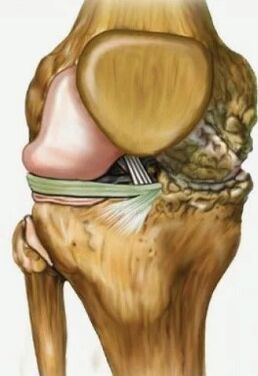
Since the disease causes featured deformations in the joints, it is called deforming osteoarthritis of the knee joint, which correctly describes the typical characteristic of the pathology. The disease is chronic and is more frequently diagnosed in women, with excess weight and venous pathologies of the lower extremities, but there may be other causes. Due to age -related changes, people also arise in older people.
Young osteoarthritis can be caused by injuries. As a result of the degenerative changes, the cartilage softens, delays and is covered with cracks of various depths. Subsequently, stop fulfilling its function.
Reasons
Several causes lead to the appearance of deforming osteoarthritis of the knee joint. A traumatic factor is a common cause of occurrence. Postraumatic osteoarthritis can be developed due to the reception of dislocation or fracture in the specified zone, as well as meniscus lesions. In general, the knee joint gonarrosis appears in young people who actively participate in sports, or in those people whose work is associated with greater mobility, elevation and weight transfer.
Few people know that such damage can be a consequence of treatment, when the injury itself is already cured, but during the long -term immobilization of the limbs there were circulatory disorders in this area. Because of this, gonarrosis appeared.
The increase in the physical effort in the knee is one of the main factors in the appearance of the disease. Most of the time it affects athletes who have constant active loads in the knee. At an early age, osteoarthritis may not appear, quick changes begin after the completion of physical activity.
There is also a risk of disease in those people who, even in adulthood, do not reduce the load in the joints. In such athletes, the risk of fractures and dislocations increases, microtraumas appear. Therefore, after forty years, doctors recommend that athletes reduce loads, change to training work. They are better excluding running and squats, since it is these types of activity that, above all, load the knee joint. Most of the time, a limb is affected and gonarrosis on the left side or gonarrosis on the right side occurs.
The elimination of the meniscus becomes an essential factor for the development of the osteoarthritis of the knee joint. If for some reason the meniscos were eliminated, then this in 90 percent of the cases leads to the appearance of osteoarthritis, the so -called baking knee, during which the joint joints experience more friction than usual.
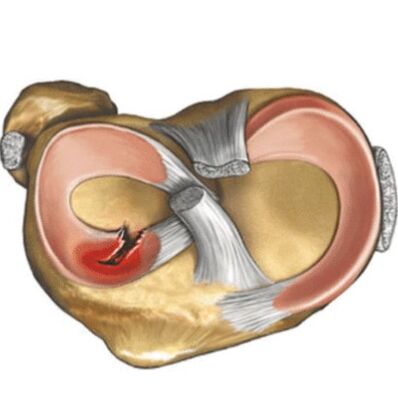
This is the case with meniscopy arthroscopy, a tear, which can become a triggering of the osteoarthritis of the knee joint
The problem of excess weight is also relevant to people with osteoarthritis. Excess body weight creates unnecessary pressure on the joints. As a result, cartilage itself is damaged, but the meniscus. And with a combination of acute and overweight osteoarthritis threatens the varicose veins of the lower extremities.
The weak ligament apparatus in some patients is an innate characteristic, and sometimes ligaments are affected by other diseases. In one way or another, weak ligaments cause greater joint mobility, so joint surfaces are significantly abrasion. The consequences of weak ligaments cannot be felt for a long time until patients experience the symptoms of true osteoarthritis.
Joint pathologies also lead to the development of the disease. Very often, osteoarthritis becomes the culprit of the appearance of osteoarthritis - inflammation of the joint joints. With arthritis, typical signs are observed: a deterioration in the composition of the synovial fluid, pathological changes in cartilage, swelling, redness of soft tissues. Even after osteoarthritis, chronic processes lead to the appearance of osteoarthritis.
The violations of metabolic processes often lead to pathologies of the musculoskeletal system. Bones and joints do not receive nutrients and minerals, so it is necessary for tissue resistance. With its lack of bone and cartilage surfaces they are subject to destructive processes, therefore, even with a slight load, primary osteoarthritis appears.
Symptoms
The osteoarthritis of the knee joint is manifested by a complex of characteristics that are difficult not to notice. There are no signs only in the first degree of development of pathology, but the second and third grade give clear symptoms of the osteoarthritis of the knee joint:
- Pain is one of the key signs, which is not manifested by an imitation diamond. It is interesting that with the development of osteoarthritis, pain cannot be felt even for several months or years until the disease is aggravated. Usually, the first pain signs are discomfort in physical effort, walking or running, but also manifests when a meniscus is pinned. In the second degree of osteoarthritis, articulation pain feels stronger, and with the third degree of development, painful sensations appear even at rest. The attacks are aggravated even after short walks without a strong load in the joint, so patients try to save the knees;
- Deformations: manifestations become increasingly pronounced in the third stage of osteoarthritis development. The knee will maintain its usual shape, but it looks slightly swollen, swollen. When arthritis binds, the knee becomes red, it will put hot and painfully on touch;
- Cryst with osteoarthritis appears in the second and third degree of disease development. Crispy sounds differ from healthy clicks, which can sometimes be heard when extending and folding the knee. With osteoarthritis, symptoms are characterized by a dry and rude sound, which occurs abruptly and is accompanied by pain;
- The synovitis is the accumulation of a certain amount of liquid in the joint cavity. It is also contained there. But the accumulation of an excessive amount leads to the development of a cyst: the baker cyst, which can be determined in the exposed leg of the leg, is more notable;
- Limited mobility in the knee is a typical pathology sign, since patients first try to protect from pain consciously and at a late stage of osteoarthritis, they cannot bend the limb. In the third degree of development, the deforming osteoarthrosis of the knee joint (DOA) even leads to the loss of movements. Patients adapt to move on folded legs, using support products.
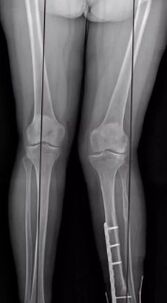
The degree of development
The osteoarthritis of the knee joint takes place in its development of three degrees.
With the first grade osteoarthritis, painful pain and occurs only with an active physical effort in the knee joint. Already in the first degree, the liquid in the cavity can accumulate, which in the second and third is already a cyst. With progression, pain occurs in the movement process, but it happens quickly. Externally, the deformation of the knee joint is invisible, so the diagnosis of osteoarthritis of the knee joint can be difficult.
Arthrosis pain even appears when the external signs of the disease are not notable
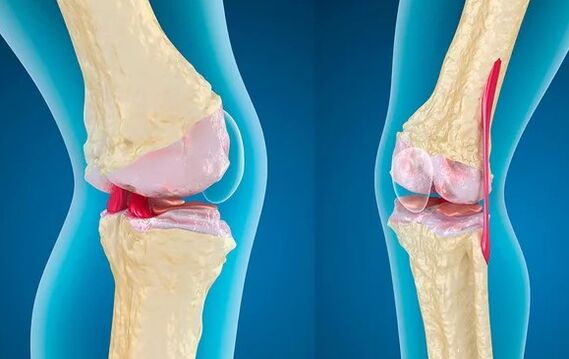
With a second degree disease, cartilage tissue damage is more significant. If you take an X -rays, then the stage of bone growth is already noticeable in it. With any movement, acute sudden pain appears in the knee, but, returning to a convenient position, the knee does not hurt. In Doa's second stage, you can listen to a typical crunch of osteoarthritis. When progressing, the problems with the extension and flexion of the knee are aggravated. The deformation becomes remarkable in appearance.
The osteoarthrosis of the knee joint of the third grade is characterized by significant slimming of the cartilage. Little by little, the cartilage is soaked so much that the bone is exposed in some areas. Image X -Ray shows a significant amount of osteophytes: bone growth, salts that appeared in the joint cavity. Externally, the changes are clearly visible, and the patient is concerned about constant pain. It is easy to make a diagnosis, there is enough visual examination and a retrigen control is carried out.
With the progression of this degree, osteoarthritis can lead to a complete loss of functionality. In any degree of development of pathology, knee joint osteoarthritis can join.
Treatment
Conservative
A group of more active drugs against osteoarthritis are non -steroid anti -inflammatory medications. These are mainly cycloxigenase-2 inhibitors, they can perfectly relieve inflammation, swelling and contribute to the rapid recovery possible. These medications have significant restrictions, so they cannot be used without the doctor's recommendation. For example, they can aggravate a stomach ulcer, heart disease and urinary organ pathologies. Non -steroidal anti -inflammatory drugs are prohibited during pregnancy.
The second group of funds are the condoprotectors that improve the characteristics of the cartilage. They are used for osteoarthritis to restore the correct structure of the cartilage, because in the resolution process it loses very important components: chondroitin and glucosamine. Therefore, almost all condoprotectors have both substances, but some medications are a component. With the help of these medications, it can help the patient in the first and second stage of the development of the disease, but not in the third, when irreversible changes occurred.
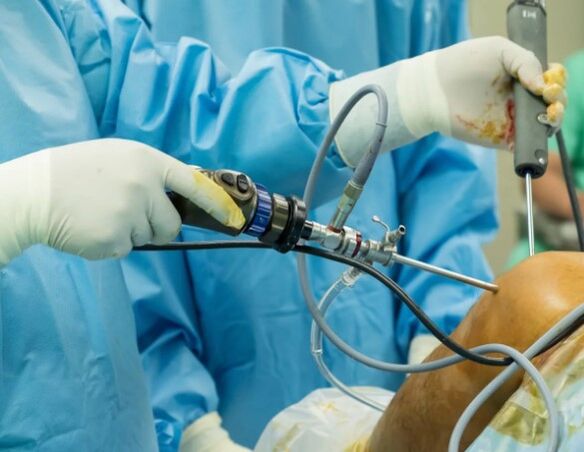
In the course of conservative therapy, the doctor will give nutrition recommendations. If a patient is overweight, it is necessary to adhere to a diet to normalize the weight. How to strengthen the stable weight: the doctor will say it too. Nor is it recommended to eat a lot of salt, but it is better to fill the diet with calcium, vitamins and minerals. The gelatin, gelatin, will be useful.
Operational
The most common type of surgical intervention for osteoarthritis is arthroscopy, but other interventions are carried out. The treatment of the osteoarthritis of the knee joint is usually carried out in the second and third degree, when conservative therapy no longer helps.
If necessary, a minimally invasive intervention, for example, by accumulating a liquid in the knee joint, it is possible to see with a puncture. In the cavity of the knee joint, a puncture is made and excess fluid is pumped. This method can be diagnosed with the disease, so it is applied simultaneously for treatment. The liquid is taken in the initial stage in a minimum amount, but this already significantly improves the well of the patients. Then, after the biomaterial study, another part is eliminated and corticosteroids are introduced into the joint cavity.
Endoprothetics is sometimes the only output for patients with third grade osteoarthritis
Arthroscopy is more common. Through a small incision, several tools are introduced into the skin, which allow it to perform an joint exam and the necessary manipulations in it. With the help of arthroscopy, you can eliminate particles of separate fabrics from the cartilage, but there is always the risk of secondary gonarrosis.
With severe damage, it is necessary to carry out perosemantial osteotomy. This is a larger effect on the joint, as a result of which it feeds slightly and installed at the right angle. After the operation, the rehabilitation is longer, but the effect lasts longer.
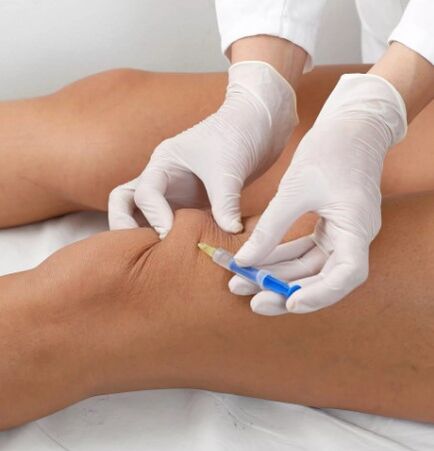
The significant destruction of the joint elements leads to the complete immobilization of the limb. The Board does not fulfill its function, which means that it needs to be replaced and that the operation must do. Endoprothetics of the knee joint is a expensive operation, but the one that makes it possible to return the movement to the patient in the limb. Several knee prostheses are installed: plastic, ceramics or metal. These are lasting constructions that allow you to forget the problem for several decades.
Physiotherapeutic
Physiotherapy methods can only be used when the acute period has passed and the patient is recovering.
Among the techniques are actively used:
- Ozone therapy is the effect on the affected joint of the ozone, and the substance can be introduced into injection or applied as external treatment. This type of patient assistance is very effective, therefore, it is often used in the treatment of several pathologies, including osteoarthritis. The treatment allows to activate blood circulation in the problem area, to achieve an anti -inflammatory and analgesic effect. At the same time, treatment with glucocorticoids is carried out;
- Kinesiotherapy: The treatment is carried out using a special set of exercises. The load is formed taking into account the individual data, and when performing exercises, special simulators are used that strengthen the joints. The difference between kinesiotherapy and physiotherapy exercises in active effects not only on knee osteoarthritis, but also throughout the body as a whole.
They use not only ozone therapy and kinesiotherapy, but also physiotherapy exercises. Good results are given by copyright methods to eliminate knee osteoarthritis: exercises in Bubnovsky, Evdokimenko, Dikul. In the course of the exercises and after them, we need to use a special knee pad, an orthosis, to strengthen the right or left knee joint.



















